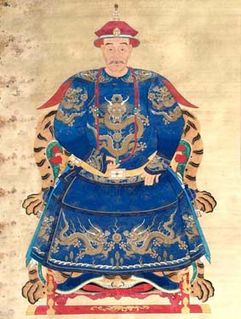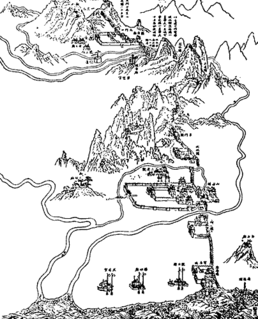| |||||
| Decades: | |||||
|---|---|---|---|---|---|
| See also: | Other events of 1674 History of China • Timeline • Years | ||||
Events from the year 1674 in China .
| |||||
| Decades: | |||||
|---|---|---|---|---|---|
| See also: | Other events of 1674 History of China • Timeline • Years | ||||
Events from the year 1674 in China .

The Qing dynasty or the Qing Empire, officially the Great Qing, was the last dynasty in the imperial history of China. It was established in 1636, and ruled China from 1644 to 1912, with a brief restoration in 1917. It was preceded by the Ming dynasty and succeeded by the Republic of China. The multiethnic Qing empire lasted for almost three centuries and assembled the territorial base for modern China. It was the largest Chinese dynasty and in 1790 the fourth largest empire in world history in terms of territory. With a population of 432 million in 1912, it was the world's most populous country.

The Kangxi emperor, personal name Xuanye, was the third Emperor of the Qing dynasty, and the second Qing emperor to rule over China proper.

The Shunzhi Emperor was Emperor of the Qing dynasty from 1644 to 1661, and the first Qing emperor to rule over China proper. A committee of Manchu princes chose him to succeed his father, Hong Taiji (1592–1643), in September 1643, when he was five years old. The princes also appointed two co-regents: Dorgon (1612–1650), the 14th son of the Qing dynasty's founder Nurhaci (1559–1626), and Jirgalang (1599–1655), one of Nurhaci's nephews, both of whom were members of the Qing imperial clan.

Wu Sangui, courtesy name Changbai (長白) or Changbo (長伯), 1612 – 2 October 1678, was a Chinese military leader who played an instrumental role in the fall of the Ming dynasty and the establishment of the Qing dynasty in its place.

Chen Yuanyuan (1624–1681) was a courtesan who lived during the late Ming and early Qing dynasties. She was the concubine of Wu Sangui, the Ming dynasty general who surrendered Shanhai Pass to the Manchu Qing dynasty, and later rebelled in the Revolt of the Three Feudatories. Chen's life and relationship to Wu later became the subject of a number of popular stories and legends, many of them focusing on her supposed role in Wu's fateful decision to defect to the Qing, thereby sealing the fate of the Ming dynasty.

The Revolt of the Three Feudatories, also known as the Rebellion of Wu Sangui, was a rebellion in China lasting from 1673 to 1681, during the early reign of the Kangxi Emperor of the Qing dynasty (1644–1912). The revolt was led by the three lords of the fiefdoms in Yunnan, Guangdong and Fujian provinces against the Qing central government. These hereditary titles had been given to prominent Han Chinese defectors who had helped the Manchu conquer China during the transition from Ming to Qing. The feudatories were supported by Zheng Jing's Kingdom of Tungning in Taiwan, which sent forces to invade Mainland China. Additionally, minor Han military figures, such as Wang Fuchen and the Chahar Mongols, also revolted against Qing rule. After the last remaining Han resistance had been put down, the former princely titles were abolished.

The Green Standard Army was the name of a category of military units under the control of Qing dynasty in China. It was made up mostly of ethnic Han soldiers and operated concurrently with the Manchu-Mongol-Han Eight Banner armies. In areas with a high concentration of Hui people, Muslims served as soldiers in the Green Standard Army. After the Qing consolidated control over China, the Green Standard Army was primarily used as a police force.

Zheng Jing, Prince of Yanping, courtesy names Xianzhi (賢之) and Yuanzhi (元之), pseudonym Shitian (式天), was a 17th-century Chinese warlord, Ming dynasty loyalist and ruler of the Kingdom of Tungning in Taiwan.

The Battle of Shanhai Pass, fought on May 27, 1644 at Shanhai Pass at the eastern end of the Great Wall of China, was a decisive battle leading to the beginning of the Qing dynasty rule in China proper. There, Qing Prince-Regent Dorgon allied with former Ming general Wu Sangui to defeat rebel leader Li Zicheng of the Shun dynasty, allowing Dorgon and the Manchus to rapidly conquer Beijing and replace the Ming dynasty.

Geng Jingzhong was a powerful military commander of the early Qing dynasty. He inherited the title of "King/Prince of Jingnan" (靖南王) from his father Geng Jimao, who had inherited it from Jingzhong's grandfather Geng Zhongming.

Shang Kexi was a Chinese general of the Ming and Qing Dynasties. His family had migrated to Liaodong in 1576 and his father, Shang Xueli, served in the army guarding the northeast frontier. As his father did, Shang Kexi joined the army and guarded the frontier against the attack of the Jurchens. With the decay and fall of the Ming Emperors, Shang Kexi sought better fortune in the service of the Qing Dynasty and he was one of the most powerful generals that surrendered to the Qing. He fought for the Qing in Southern China and established his power in Guangdong where he ruled the territory as his own domain amassing wealth and possessing a trained army.

The transition from Ming to Qing, Ming–Qing transition, or Manchu conquest of China from 1618 to 1683 saw the transition between two major dynasties in Chinese history. It was the decades-long conflict between the emergent Qing dynasty (清朝), the incumbent Ming dynasty (明朝), and several smaller factions in China. It ended with the rise of the Qing, and the fall of the Ming and other factions.

Shang Zhixin was a major figure in the early Qing Dynasty, known for his role in the Revolt of the Three Feudatories. He was Prince of Pingnan, inheriting his position from his father, the surrendered Ming Dynasty general Shang Kexi.
Wu Yingxiong was a Chinese aristocrat and the eldest son of Chinese military general Wu Sangui who was instrumental in the fall of the Ming Dynasty and the establishment of the Qing Dynasty in 1644.
Events from the year 1662 in China.
Events from the year 1663 in China. Also known as 壬寅 4359 or 4299 to 卯年 4360 or 4300 in the Earthly Branches calendar.
Events from the year 1673 in China.
Events from the year 1678 in China.